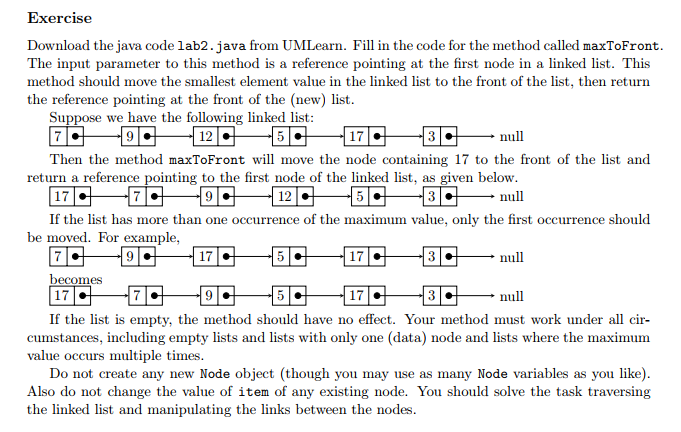Question
lab2.java : import java.util.Random; public class lab2 { public static void main(String[] args){ LinkedList ll = createLinkedList(); //create a link list and top will point

lab2.java :
import java.util.Random;
public class lab2
{
public static void main(String[] args){
LinkedList ll = createLinkedList(); //create a link list and top will point to the start of the linked list
// print the items in the original linked list
System.out.println("Original List:");
ll.printList();
// move the minimum element to the front of list
System.out.println("Altered List:");
ll.maxToFront();
// print the items in the new linked list
ll.printList();
}
//this method creates an unordered linked list filled with random values
//you can modified this routine to generate other kinds of test data
public static LinkedList createLinkedList() {
//use random number generator to generate a random list of numbers
LinkedList ll = new LinkedList();
Random rn = new Random();
int n = rn.nextInt(100)%11; /umber of inputs between 0 and 10.
int[] a = new int[n];
int num;
Node top = null;
for (int i = 0;i
num = rn.nextInt(Integer.MAX_VALUE)% 10;
ll.insert(num);
}
return ll;
}
}
class LinkedList{
private Node top; //reference to first node in list
/***
*LinkedList - initialize list to empty list
***/
public LinkedList() {
top = null;
}
/***
* maxToFront - Move the node with the minimum value to the front of list
*
* PARAM INPUT top: a reference pointing at the first node in the list
*
* RETURN a reference pointing at the first node in the new list
***/
public void maxToFront(){
// fill in your code here
}
/***
* insert - insert a new node to front of list
*
* PARAM INPUT i: data for the new node to be inserted
***/
public void insert(int i) {
Node newNode = new Node(i,top);
top = newNode;
}
/***
* printList - Print the items in a linked list
*
* PARAM INPUT top: a reference pointing at the first node in the list
***/
public void printList(){
Node curr = top;
while (curr != null){
System.out.print(curr.item + " ");
curr= curr.next;
}
System.out.println();
}
}
//A node in a singly-linked linked list
class Node
{
public int item; //data to be stored
public Node next; //reference to the next node (set to null if no such node exists)
public Node(int item, Node next){
this.item = item;
this.next = next;
}
public Node(int item){
this.item = item;
this.next = null;
}
}
Exercise Download the java code lab2.java from UMLearn. Fill in the code for the method called maxToFront The input parameter to this method is a reference pointing at the first node in a linked list. This method should move the smallest element value in the linked list to the front of the list, then return the reference pointing at the front of the (new) list Suppose we have the following linked list 9 12 null Then the method maxToFront will move the node containing 17 to the front of the list and return a reference pointing to the first node of the linked list, as given below 17 9 12 null If the list has more than one occurrence of the maximum value, only the first occurrence should be moved. For example, becomes 17 null If the list is empty, the method should have no effect. Your method must work under all cir cumstances, including empty lists and lists with only one (data) node and lists where the maximum value occurs multiple times Do not create any new Node object (though you may use as many Node variables as you like) Also do not change the value of item of any existing node. You should solve the task traversing the linked list and manipulating the links between the nodesStep by Step Solution
There are 3 Steps involved in it
Step: 1

Get Instant Access to Expert-Tailored Solutions
See step-by-step solutions with expert insights and AI powered tools for academic success
Step: 2

Step: 3

Ace Your Homework with AI
Get the answers you need in no time with our AI-driven, step-by-step assistance
Get Started


